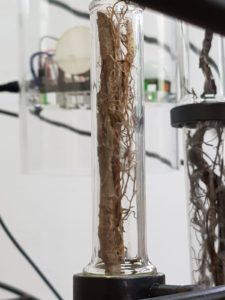- Arboris
- Arboris dettaglio
- Arboris dettaglio
- Arboris dettaglio
- Arboris dettaglio
“Arboris – Scultura olfattiva – Radici di alberi e piante, vetro, ferro, cialde olfattive, circuiti elettronici, plexiglass – 85x48cm
“Arboris” – Olfactory sculpture – Roots of trees and plants, glass, iron, olfactory pods, electronic circuits, plexiglass – 85x48cm
Deforestation is one of the greatest environmental problems of our time: the impact that this phenomenon is already having on our ecosystem is alarming. Deforestation is the indiscriminate reduction of forests and woodlands. It is a process that leads to the intensive exploitation of natural green areas around the world, but in light of the devastating effects this is having, efforts are being made to implement a series of protection and reforestation measures. However, the scale of the phenomenon is so great that it is now difficult to remedy. Some of the most influential western countries are trying to remedy this problem for which they are jointly responsible, but developing countries believe they have the full right to exploit the forests just as western countries have done in the past. Deforestation is a historical phenomenon: from ancient Rome to the present day, man “scalps the Earth”. It is an irrational action, the causes of which include the need for new arable land, timber for fuel and the demand for valuable wood. The consequences of deforestation include an increase in the greenhouse effect, climate change, hydro-geological risks and reduced biodiversity. Forests are our cradle. It is where we took our first steps as a species and without it we could not exist. They are the green lung of the planet, providing us with food, oxygen and resources. This is why we need “protection”: hence the need for a work that can evoke this action. The shape of a nest (cradle and protective belly) symbolically becomes the action of care that man should have towards the forests, represented in the work by various samples of tree and plant roots. The roots are placed inside glass ampoules, a material chosen because it is one of the most ancient and closely linked to the history of different civilisations. Glass reflects a decision for our future, protects the environment, preserves our natural resources as it is practically infinitely reusable, recyclable and eco-friendly. Inside the structure, located between the ampoules, there is a small olfactory area made with olfactory pods which, stimulated by the action of two fans, will diffuse odours linked to nature such as, for example, essences of undergrowth and flowers. The public will thus be able to approach the “olfactory breath” of nature: nature which we have a duty to preserve.
La deforestazione è uno dei più grandi problemi ambientali della nostra epoca: l’impatto che questo fenomeno può avere (e sta già avendo) sul nostro ecosistema è di portata allarmante. Con deforestazione si intende la riduzione indiscriminata di boschi e foreste: si tratta di un processo che porta allo sfruttamento intensivo di aree verdi naturali presenti nel mondo, ma alla luce degli effetti devastanti che tutto questo sta producendo, si sta cercando di mettere in atto una serie di misure di tutela e di rimboscamento.
Tuttavia, il fenomeno ha una tale portata che sembra difficile, ormai, poter rimediare.
Alcuni fra i più influenti paesi occidentali stanno cercando di di porre rimedio a questo problema di cui sono corresponsabili, ma i paesi in via di sviluppo ritengono di avere il pieno diritto di sfruttare le foreste proprio come avevano fatto a loro tempo i paesi occidentali.
La deforestazione è un fenomeno storico: dall’antica Roma a oggi l’uomo “fa lo scalpo alla terra”.
Un’azione irrazionale, di cui le cause sono il bisogno di nuove aree coltivabili, legname come combustibile, domanda di legno pregiato.
Fra le varie conseguenze della deforestazione ci sono l’aumento dell’effetto serra, i cambiamenti climatici, il rischio idrogeologico e una minore biodiversità.
Le foreste sono la nostra culla. Lì abbiamo mosso i nostri primi passi come specie e senza di loro non potremmo esistere.
Il valore delle foreste è enorme sono il polmone verde del pianeta, ci forniscono cibo, ossigeno e risorse. Per questo c’è bisogno di “protezione”: ecco allora nascere l’esigenza di un’opera che possa evocare quest’azione.
La forma di un nido (culla e ventre protettivo) diventa simbolicamente l’azione di accudimento che l’uomo dovrebbe avere nei confronti delle foreste, nell’opera rappresentate da vari campioni di radici di alberi e piante.
Le radici sono inserite dentro ampolle di vetro, materiale scelto in quanto tra i più antichi e strettamente legato alla storia delle diverse civiltà.
Il vetro rispecchia una decisione per il nostro futuro, tutela l’ambiente, preserva le nostre risorse naturali in quanto riutilizzabile praticamente all’infinito, riciclabile ed ecologico-ecocompatibile.
All’interno della struttura, collocata tra le ampolle, sarà presente una piccola area olfattiva realizzata con cialde che, stimolate dall’azione di alcune ventole, dipaneranno odori legati alla natura quali, per esempio, essenze di sottobosco e fiori.
Il fruitore dell’opera avrà cosi la possibilità di avvicinarsi anche al “respiro olfattivo” della natura: natura che abbiamo il dovere di preservare.




